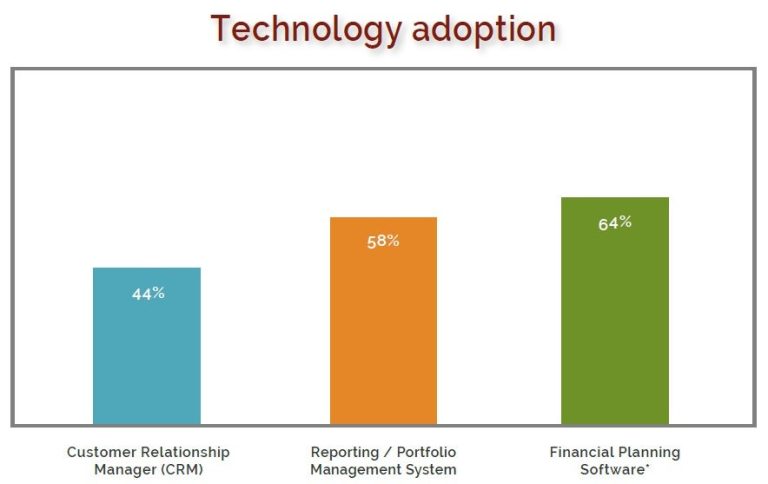When an advisor is looking to create a new registered investment adviser (RIA) firm, we are often asked what technology is ideal for a new firm. We like to approach this question with a 5 step process: 1) review a firm’s specific business operations to determine particular needs, 2) establish an initial monthly technology budget, 3) determine the firm’s desire to “build” vs. “buy” 4) decide on general small business applications and other infrastructure, and 5) select specific RIA technology and software solutions.
As a follow up on our previous blog post on step 4 of the process on how to select general small business applications and infrastructure, we now discuss step 5 of the RIA technology evaluation process: selecting specific RIA industry technology and software solutions. We generally define investment adviser industry software as technology that was designed for use exclusively for the investment adviser or broader financial advisor industry. Whereas most small businesses may need a website, firms in the investment advisory industry have unique technology needs specific to managing, reporting on, billing on, and communicating about their clients’ investment portfolios and financial goals.
As demonstrated in our recently published RIA technology landscape infographic, investment adviser technology offerings continue to rapidly evolve. We generally define the industry technology categories as:
- Customer relationship management (CRM)
- Portfolio management / reporting (PMR)
- Financial planning
- Document management / storage
- Archiving
- Data aggregation
- Rebalancing
- Portfolio risk
- Billing
- Marketing / lead generation
The three investment adviser industry software categories that we see most commonly adopted by RIA firms are CRM, PMR, and financial planning. Preliminary results from our 2015 RIA Technology and Investment Operations Survey of over 850 RIA firms reveals the following:

* Only includes firms that offer financial planning services
As to be expected, adoption of these key software components does trend upward as the assets under management (AUM) for a firm increases. In particular, we see a significant increase in RIA firms purchasing customer relationship management and portfolio management software once the firm reaches around $10-15 million in AUM:

* Only includes firms that offer financial planning services
However, along with the rapid evolution of technology in the investment advisory space, the lines between traditional “categories” are becoming more blurred. Some systems fall into multiple categories as they may function for example as a combined portfolio management / reporting, data aggregation, and billing tool. On the other hand, many systems are exclusively focused on a specific task such as CRM, rebalancing or archiving.
Given this overlap between different software solutions, we instead often advise the principal of an investment advisory firm to begin the RIA technology selection process by first defining the key business tasks that the integrated system or platform will need to be able to perform. This process allows the principal to approach the technology diligence and purchasing process in a more efficient manner. Rather than blindly demoing a number of potential solutions, the principal can first ask vendors specific questions to see if the system(s) will meet the firm’s critical needs.
A few key requirements discussed in our Ten Critical Features of an RIA Technology System checklist that many new RIA firms often underestimate are:
- Calculating advisory fees and processing client billing invoices
- Most new investment advisory firms quickly realize that the quarterly (or monthly) client billing process is quite burdensome without proper technology. Furthermore, billing clients based on the average daily account balance becomes exceptionally difficult without the right technology (and no, Microsoft Excel is not a sufficient billing solution). It’s also important to note that many state-registered RIA firms are required to send separate billing invoices to clients. Our team has written extensively about RIA client billing and has also authored a white paper at RIA billing.
- Sharing information online with a client in a secure and professional manner
- Gone are the days of the quarterly client meeting with the 20-page presentation deck, clients expect to be able to check in on their investment 24/7 online and on their smart phones or tablets. Investment advisory firms need to have a branded and professional client portal that allows clients to view key investment portfolio details.
- Ability to proactively monitor where the firm and an individual investment adviser representative (IAR) should be registered to meet regulatory requirements
- As RIA compliance consultants, one of the most common regulatory compliance challenges we see is a firm and/or a firm’s individual representatives not being properly registered in all of the required jurisdictions. A properly constructed investment adviser technology system needs to be able to proactively alert an investment advisory firm when it may be close to reaching a jurisdiction’s requirement to register or notice file.
Be sure to check out our previous four blog posts on steps 1-4 of selecting the proper technology for a new RIA firm:
- Review of an RIA firm’s business operations to determine specific technology needs
- Establishing an initial RIA monthly technology budget
- Deciding whether to “buy” or “build” an RIA technology system
- General small business software and infrastructure that an investment advisory firm needs
